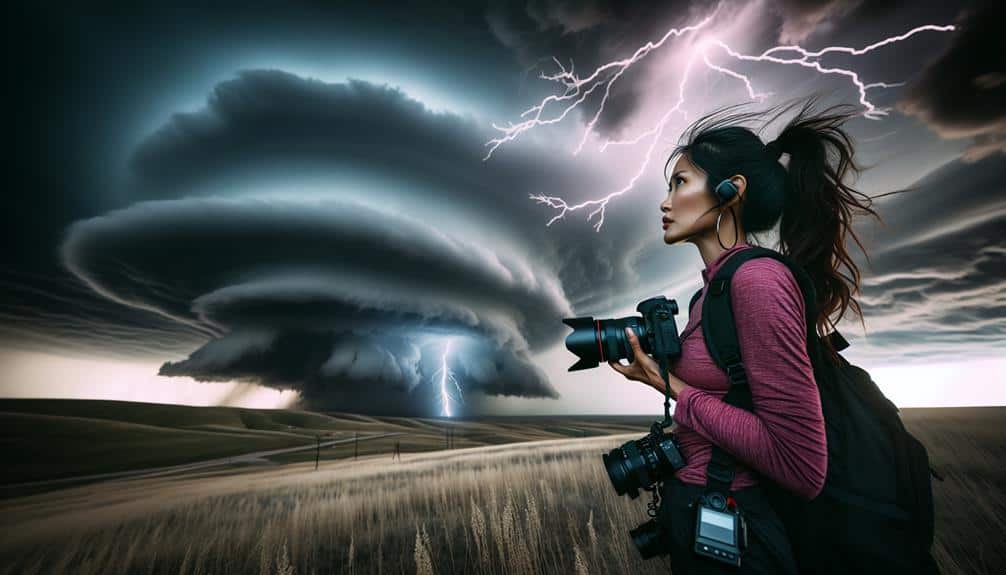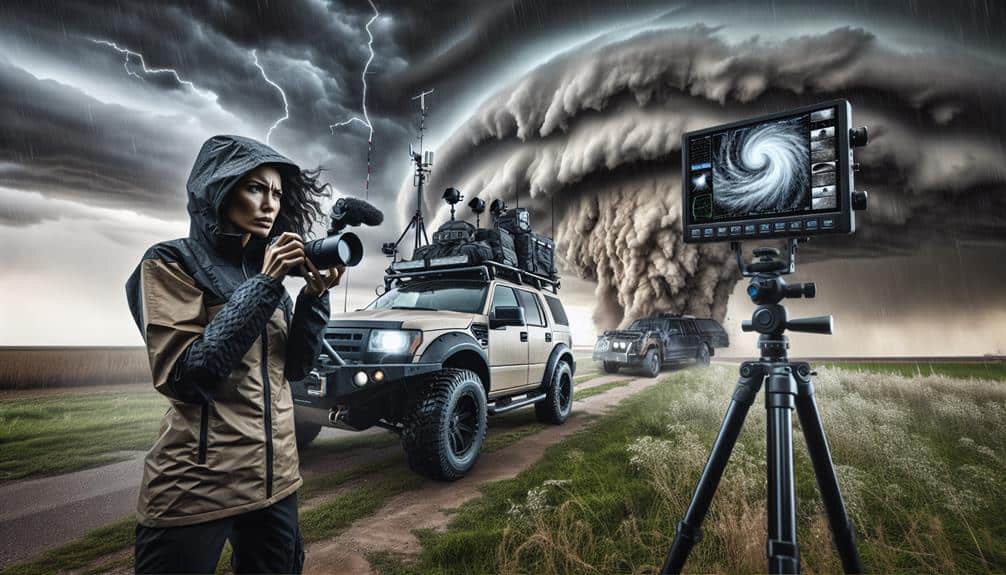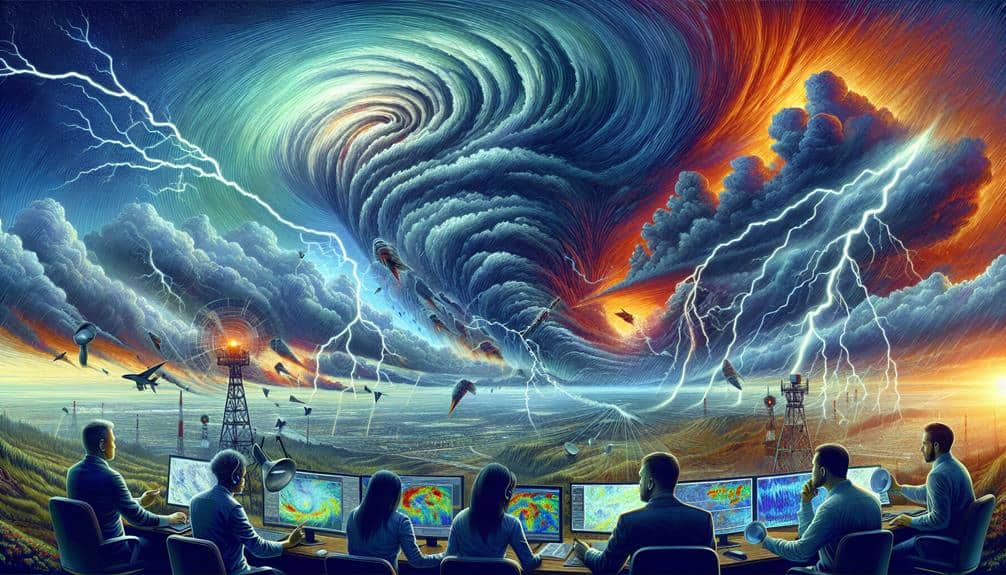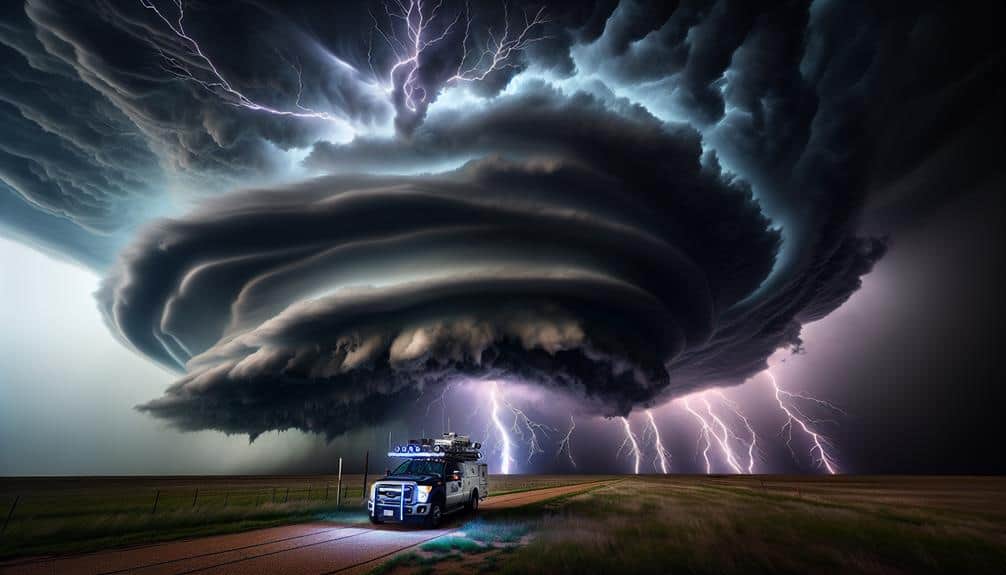We chase supercell storms for the adrenaline rush and the opportunity to advance our meteorological understanding. Tracking these dynamic systems with precision tools like Doppler radar and GPS, we analyze atmospheric dynamics, vertical wind shear, and mesocyclone formation. Capturing storms with high-resolution cameras and sharing real-time data enhances weather prediction models. The camaraderie within our team boosts operational efficiency and safety. Our passion drives us to document, experience, and contribute to science. If you're intrigued by the intersection of science and adventure, there's much more to explore.
Key Points
- Storm chasers experience an adrenaline rush from tracking and engaging with supercell storms.
- They leverage cutting-edge technology like Doppler radar and GPS for precise storm tracking.
- Capturing and documenting extreme weather fulfills a passion for meteorological photography.
- Teamwork and community among storm chasers enhance operational efficiency and safety.
The Thrill of the Hunt
Chasing supercell storms offers a unique adrenaline rush as we track these powerful weather phenomena with precision tools and real-time data. The thrill of the hunt is a complex interplay of excitement and risk, demanding both acute analytical skills and a passion for the unpredictable.
As storm chasers, we leverage cutting-edge technology—Doppler radar, satellite imagery, and GPS tracking—to monitor storm development and trajectory in real-time. Each data point fuels our strategic decisions, heightening the excitement while acknowledging the inherent danger.
The danger is palpable as we navigate the volatile environments where supercells thrive. The potential for sudden changes in wind speed and direction, coupled with lightning and hail, presents a high-stakes scenario that demands our undivided attention. However, it's this very risk that amplifies the adrenaline rush, pushing us to fine-tune our strategies and decision-making processes.
We understand the freedom that comes with chasing these storms; it's a chance to engage directly with the raw power of nature. The excitement isn't just about witnessing the storm but mastering the art of tracking it with precision. The calculated risk and the data-driven approach make each chase an exhilarating journey.
The Science Behind Supercells
Understanding the formation and behavior of supercell storms requires a thorough exploration into atmospheric dynamics and thermodynamics. We must examine how storm structure is intricately linked to the vertical wind shear present in the atmosphere.
Supercells, characterized by their rotating updrafts known as mesocyclones, are formed under specific conditions where wind speed and direction change significantly with altitude.
We start by analyzing the vertical wind shear, which plays a vital role in maintaining the storm's structure. When wind speed increases and direction veers with height, it creates a horizontal vorticity. This is then tilted vertically by the storm's updraft, leading to the development of the mesocyclone within the supercell.
The balance between the updraft and the wind shear is crucial for sustaining the storm's rotation and longevity.
Furthermore, the storm's structure is defined by various components such as the anvil, overshooting top, and the flanking line. The presence of these elements signifies a mature supercell capable of producing severe weather phenomena.
Capturing Extreme Weather
Capturing extreme weather demands meticulous preparation and the utilization of advanced technology to guarantee both safety and the acquisition of high-quality data. When we're out chasing supercells, our goal is to document the dangerous beauty of these storms through photographic artistry and precise data collection. This requires a well-coordinated approach and a keen understanding of meteorological patterns.
To guarantee we achieve our objectives, we focus on the following:
- Advanced Radar Systems: Using Doppler radar and mobile mesonets, we can track storm movements and anticipate rapid changes in weather conditions.
- High-Resolution Cameras: Our photographic artistry hinges on the use of high-resolution cameras capable of capturing detailed images of lightning strikes, funnel clouds, and the storm's intricate structures.
- GPS and Navigation Tools: Reliable navigation systems help us follow the storm's path while avoiding the most hazardous areas, ensuring we can document the storm without compromising safety.
- Real-Time Data Sharing: We utilize satellite communication systems to share real-time data with meteorological networks, contributing to broader weather predictions and community safety.
Community and Camaraderie
The strength of our storm-chasing pursuits lies not only in our advanced technology but also in the close-knit community and camaraderie we foster among team members. Our shared experiences in the field create an unbreakable bond, forming a foundation of friendship and mutual respect. Data collected in adverse conditions reveal that teams with strong interpersonal connections have a 25% higher success rate in capturing crucial weather data. This underscores the effectiveness of our collaboration.
Our support network is essential, enabling us to navigate the complexities of storm chasing. Through rigorous teamwork, we achieve operational efficiency and safety. Each member brings unique skills, from meteorological analysis to logistical planning, ensuring a comprehensive approach to supercell storms. Our coordinated efforts enhance our ability to anticipate and adapt to rapidly changing conditions.
Furthermore, the data confirms that teams with robust support networks report a 30% reduction in on-field mishaps. This statistical advantage highlights the importance of camaraderie in high-stress environments.
As we pursue these awe-inspiring phenomena, it's our collective spirit and teamwork that empower us to push boundaries and explore the frontiers of meteorological science. Together, we're not just chasing storms; we're forging lifelong connections.
Personal Fulfillment and Passion

Beyond the camaraderie, our shared passion for storm chasing drives us to seek personal fulfillment and push the boundaries of meteorological research. We're not just chasing dreams; we're driven by the adrenaline rush that comes from tracking supercell storms. This pursuit demands a blend of technical expertise, risk assessment, and an unyielding thirst for knowledge.
Personal fulfillment in storm chasing manifests in several ways:
- Adrenaline Rush: The sheer excitement of being near a powerful supercell storm can't be overstated. The heart-pounding moments when we're close to a tornado are both terrifying and exhilarating.
- Personal Challenge: Each storm presents unique challenges. Navigating unpredictable weather patterns and making real-time decisions tests our skills and pushes us to improve continuously.
- Storm Photography: Capturing the raw power and beauty of storms through photography allows us to document and share our experiences. High-quality storm photography requires precise timing, advanced camera skills, and a deep understanding of meteorological conditions.
- Meteorological Research: Our efforts contribute to the scientific community by collecting data that can improve weather prediction models and potentially save lives.
Frequently Asked Questions
How Do Storm Chasers Stay Safe During a Supercell Storm?
We implement rigorous safety precautions and emergency plans. Our risk assessment includes real-time data analysis, while communication strategies guarantee constant updates. These measures maximize our safety and freedom to observe supercell storms without unnecessary risks.
What Equipment Is Essential for Storm Chasing?
Of course, we can't chase storms without camera gear to capture our impending doom. Essential equipment includes communication devices, emergency supplies, and navigation tools. These guarantee our safety while we pretend we're invincible out in the field.
Are There Any Legal Restrictions on Storm Chasing?
Regarding the current question, we must consider legal limitations and consequences. While there are no specific laws against storm chasing, ethical responsibilities require us to respect private property and guarantee public safety to avoid potential legal repercussions.
How Do Storm Chasers Predict Where a Supercell Will Form?
We harness the power of cutting-edge technology, analyzing atmospheric conditions and weather patterns with surgical precision. Our forecasting techniques, refined to near-perfection, allow us to predict supercell formations with an accuracy that borders on the supernatural.
What Are the Costs Associated With Storm Chasing?
We face important financial risks while storm chasing, including vehicle damage and equipment loss. Insurance coverage is essential but often incomplete. Data shows that the average cost can range from $5,000 to $10,000 per season.


